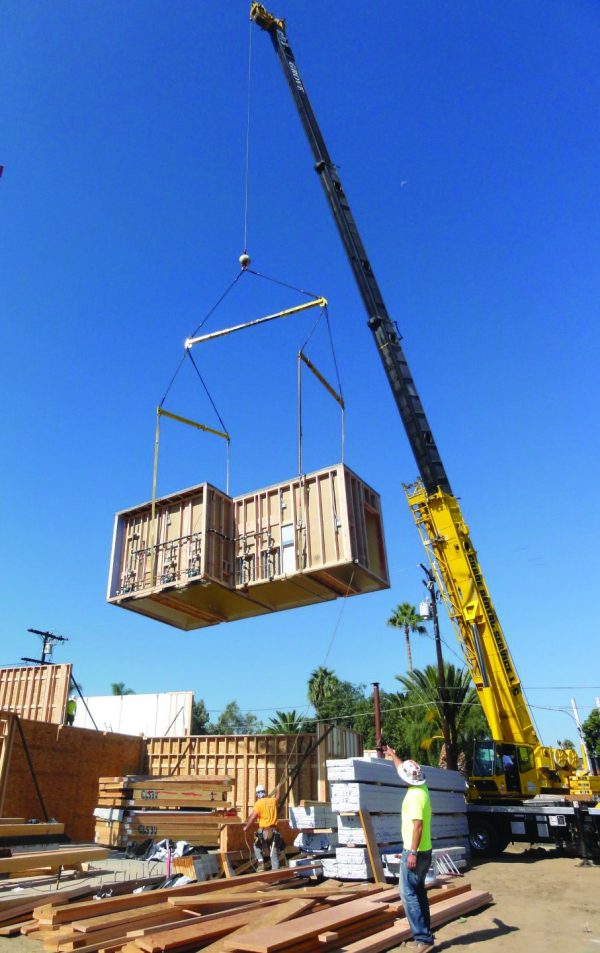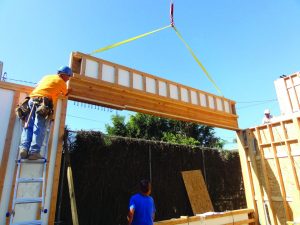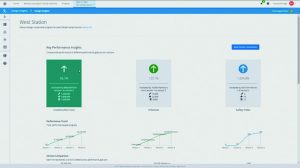Infrastructure Digitization: Two Industry Analysts Discuss Recent Tech Efforts from Autodesk and Bentley

Three Trends Defining Industrialized Construction
On the main stage of Autodesk University 2017 in Las Vegas, Jim Lynch, vice president of the Autodesk Building Products Group, highlighted Autodesk’s increased focus on the industrialization of construction. It was clear that a convergence of manufacturing and construction processes was happening.
In the next few years, this convergence will radically change the way we design buildings, build components, assemble them onsite, and manage processes and data. Buildings will be assembled from components and modules manufactured offsite, bringing standardization and simplification to the whole building process—from the architecture studio to the factory and, finally, to the jobsite.
Although the term industrialized construction was new to many at Autodesk University, it quickly became clear this movement is well underway and will impact the entire industry. The driving factor at the core of this revolution has been—and will continue to be—better data flow.
The following are three emerging trends to give us a peek into the industrial future for architecture, engineering and construction.
1. Digitization and Big Data
It’s increasingly clear that the future of construction is digital and driven by data. From 3D drone-captured photogrammetry to 5-D BIM platforms hosted in the cloud, companies throughout AEC are adopting and adapting digital data flows to improve project productivity and predictability. Although the adoption of digital technology seems notoriously slow in construction, the signs of revolution are clear: sizable investment and acquisition in digital technologies from big multinational companies seeking a leg-up in innovation; executive hiring in digital strategy and operations; and a race among practitioners to showcase and market fluency with data rich innovation—be it Virtual Reality (VR), Augmented Reality (AR) or Artificial Intelligence (AI).
2. Impact on the Industry
This turn toward digitization arrives in reaction to long-standing inefficiency and underperformance in the AEC industry (relative to the greater global economy). Research by McKinsey values unrealized productivity at $1.6 trillion, noting the fragmentation of trades and disciplines across all stages and stakeholders of a construction project as a primary contributing factor. Data loss, misinterpretation and friction in project-handoffs—due to the siloing of professional disciplines without a single-source of truth framework for collaboration—translate to higher costs and longer schedules. By some accounts, 90 percent of the world’s infrastructure projects are either late or over budget.
The success of digitization is based on the potential for multi-stakeholder synchronicity to boost productivity. Digital platforms today aim to better connect project stakeholders, track requirements and project goals, capture and aggregate real-time project data, and align work products in collaborative, cloud-based project ecosystems. For complex projects, digitization can lead to deeper integration of design and engineering disciplines, better estimating and scenario planning, and better real-time visualization and communication in and throughout each phase and location of a project. All of these can reduce the time and money spent addressing project errors, omissions and changes.
3. Automation
Automation in the AEC industry can bring to mind visions of autonomous robots moving across a jobsite to quickly assemble buildings in place of workers. In reality, the biggest shift toward automation is happening well before any material arrives at the jobsite. The prime opportunities to capture value through automation are in the studio, the factory and in optimizing design for manufacturing.
In terms of design, automation promises to condense and align workflows in engineering and architectural services, reducing the time to convert site-specific design into documentation for permitting, manufacturing and construction. With better processing power and flexible integration of cloud-based web development, design workflows are becoming more synchronous, with real-time data transfer driving instant update of building models, providing users across a project ecosystem with better tools to visualize and interact with a project as it develops.
Automation also is affecting the way building components are fabricated. Platforms for “Design for Manufacture and Assembly” (DFMA) work to fully systematize design decisions for ease of manufacturing, linking choices made in the studio to the factory workflows of mass production. Common data environments are being developed for cleaner hand-offs from architecture to manufacturing, whereby the process of manual shop-drawing will give way to data transfer and file conversion, effectively eliminating the time-consuming tasks of shop and construction drawings.

Project Frog
Further downstream, new capabilities will feed off new data flows offered through digitization, while more multi-material and multi-trade assemblies will be consolidated under one roof for production—much in the way the modern automobile industry optimized automation workflows for industrial fabrication. In this new world, the work of construction will move increasingly from the site to the factory, while libraries of available building components and assemblies will replace the procurement of raw materials traditional to the industry.
The Innovation Arms Race
Finally, amidst the clamor for innovation, an arms race for market dominance is underway, and winners and losers soon will be decided. The trend of investing in construction tech suggests a period of rapid growth with a wide range of companies benefitting from the boom, including those developing software for tracking supply chain and parts procurement; Internet of Things device makers looking to improve jobsite safety and productivity; and full-scale development companies capable of financing, designing, fabricating, and constructing large residential and commercial projects. Leading the trend is Katerra, a vertically integrated development company with an underpinning in technology, which recently closed an $865 million round of investment lead by Softbank.
In addition, acquisitions by Trimble (e-Builder), Oracle (Aconex) and significant investments by Autodesk—focused on cloud-services—suggest a need to stay competitive. For a notoriously fragmented construction industry, it’s clear a period of rapid consolidation may be underway. The likely result is the eventual emergence of a clear market leader—similar to Apple in consumer products or Amazon in marketplaces.
Where’s the Tipping Point?
The industrialized construction revolution is gaining steam now. Buyer-side mandates already are going out in requests for bidders. The influx of funding for new infrastructure will help accelerate the pace of adoption, just as housing shortages and climate-related disasters have underlined the need for greater productivity across the industry.
Already, industrialized construction is manifesting itself in many facets of the construction industry. Retail, healthcare and residential development are increasingly relying on predictable, shortened construction schedules—along with the increased flexibility—of prefab building systems to address current market trends. In addition, the shortage of qualified labor, volatility in material pricing and even inclement weather are forcing the industry to address the resulting longer build times and higher costs for traditional, stick-built construction.
For competitors to remain relevant within the AEC industry, they must plan for their own adoption to integrated design, manufacture and build. That adoption and convergence will depend on new data flow processes, and digital technology will be at the heart of the movement.
Managing Change in Infrastructure
Bentley Systems’ iModel 2.0 Platform Is Built for the Cloud
The wholesale movement of business to cloud-based computing—a movement some are calling the “fourth Industrial Revolution”—has been slower and more difficult for design-intensive sectors such as manufacturing and infrastructure. Bentley Systems founder and Chief Technology Officer Keith Bentley believes he knows why.
“Infrastructure projects have unique characteristics,” he writes in “Bentley’s iModel 2.0 Platform,” a recent white paper co-authored by Casey Mullen, an architect with Bentley. “They involve many collaborating disciplines where the work is interconnected, with thousands of asynchronous decisions and changes for material choices, design, aesthetics, structural integrity, safety, and more.”
Pointing to a solution, Bentley adds, “If constant and unrelenting change characterizes infrastructure projects, then it would seem self-evident that our systems should be designed from the ground up to manage change. We need to move away from a futile attempt to maintain a single model of a design as the ‘current record,’ as the very concept of ‘current’ is ephemeral in infrastructure. We need a new paradigm for managing change—a better solution for synchronizing work in infrastructure projects.”
That new paradigm, which emphasizes change as the critical factor in managing infrastructure projects, underlies the iModel 2.0 cloud platform, which is Bentley’s new hub for managing virtually all information and change generated during the design, construction and operation of infrastructure facilities. According to the introductory white paper, iModel 2.0 is distinguished from existing cloud platforms by four factors:
1. It is “architected from the ground up to manage change” and features continual access to all versions of the model, at any time. A “timeline of changes” tracks authorship, time and content of all changes.
2. It is a “distributed relational database” that contains specifications, analysis, related drawings and other information in addition to the design model.
3. It facilitates unlimited copying of the model to any device or service, including mobile devices. Models can be used offline and synchronized remotely via iModelHub, which avoids a centralized bottleneck.
4. It continues Bentley’s legacy of making its products interoperable with other vendor solutions as well as its own, and in preserving existing workflows. With this platform, iModelHub is being distributed via the ProjectWise iModel Bridge Service. The two services work together to incorporate changes to models based on any existing application or format.
Accountability and Accessibility
When explaining the importance of tracking changes in the infrastructure industry, Keith Bentley used this analogy: “Imagine a bank account that only showed your current balance—without the transaction history to show how that balance was achieved. Most people would find lack of a transaction history entirely unacceptable, yet infrastructure professionals are currently living with such limitations—they can only see the current state of their engineering data. Change in data is the source of both value and risk in infrastructure workflows.”
The new platform uses several techniques to provide a “transaction history” of project changes. The white paper states that “iModelHub is the hub of engineering data and change in the connected data environment. Its timeline of changes facilitates automated digital workflows, as-needed synchronization of iModels and insights into how the data is changing.” Crucially, every transaction is tracked on a “per-property basis,” and every changed value is attributed to an author. All change-tracking information is rich and easily communicated to globally distributed teams working on different platforms.
This tracking of change and its authorship—accountability—combines with an information-rich change publication system—accessibility—and makes iModel 2.0 a breakthrough platform for distributed infrastructure design and engineering work. The iModelHub, along with the iModel Web software development kit (SDK), is the key feature. It supports an entire “ecosystem” of applications, workflows and devices in the same way a smartphone operating system supports multiple vendors, users and applications.
Third (non-Bentley) parties can create and publish custom applications for global use. Users also can combine iModels (the reality data from sources such as scanners, surveys and photo capture) with rich information from data pools such as aerial photography archives. These data-rich models and project databases can be published on the web with full 3D browsing capacity, filtering and property extraction.
This work is extended into construction and operation, allowing the iModel and change timelines to become the richest as-built representation of assets yet. Changes and updates to infrastructure facilities will be designed and recorded in the iModel. The SDK and iModelHub applications will allow for detailed analysis of the facility, such as with structural engineering or solar gain applications. Bentley even anticipates the emergence of artificially intelligent solutions that will use the iModel to monitor facilities for the most-effective operations.




Getting There from Here
Bentley Systems realizes that existing infrastructure workflows already are incredibly rich and complex, and a platform with even more richness and complexity can seem daunting. To address these concerns, the iModel 2.0 cloud platform includes the ProjectWise iModel Bridge Service, which brings models and projects started in Bentley and other vendors’ applications into iModel 2.0. The bridge service has three main functions:
1. Transform “dark” data from other applications into rich “semantically aligned” data supported by the iModel platform. Many existing applications create a lot of useful change data, but much of these data aren’t visible to users. The bridge service analyzes the data, and makes them accessible to users and applications in useful ways.
2. Look at incremental changes and authors to create a timeline from most models.
3. Aggregate change from multiple models and other design work into one aligned iModel.
Ultimately, the bridge service is intended to transform existing work into a form that can leverage the iModel platform’s many applications and services, and immediately take advantage of a system designed to track and manage an infrastructure project’s most important characteristic: change.
For more information about iModel 2.0 and iModelHub, download the full white paper and view videos at https://www.bentley.com/en/yii/video-gallery#iModelHUB.
About Angus Stocking
Angus Stocking is a former licensed land surveyor who has been writing about infrastructure since 2002 and is the producer and host of “Everything is Somewhere,” a podcast covering geospatial topics. Articles have appeared in most major industry trade journals, including CE News, The American Surveyor, Public Works, Roads & Bridges, US Water News, and several dozen more.


